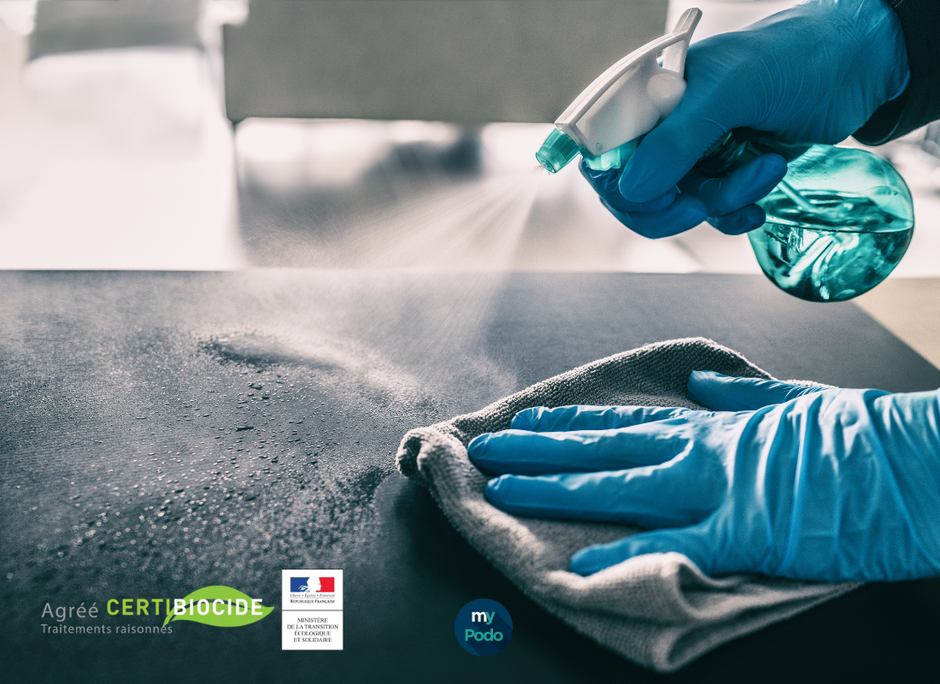Le pied diabétique neurologique est une complication liée à la neuropathie diabétique, touchant près d’un patient sur deux après 20 ans d’évolution du diabète. La micro-angiopathie aboutit à l’altération des microvaisseaux de l’épinèvre et de l’endonèvre du nerf. Au niveau des cellules de Schwann, la transformation du glucose en excès en sorbitol conduit à une altération de la membrane cellulaire, donc de la gaine de myéline, entraînant finalement une dégénérescence nerveuse.
Signes cliniques du pied diabétique neurologique
L’atteinte des fibres nerveuses contenues dans les nerfs est appelée multinévrite ou, plus fréquemment, polynévrite diabétique, en raison de la symétrie des troubles. Cette condition constitue le tableau clinique dans plus de 90 % des cas.
I – La neuropathie autonome (ou végétative)
1 - L’atteinte des fibres du système nerveux autonome ou végétatif, et en particulier des fibres sympathiques des nerfs, entraîne une mauvaise répartition du flux sanguin dans les structures du pied.
Au niveau de la peau, le pied neurologique se caractérise par une chaleur relative, des pouls parfois bondissants, une peau épaisse et sèche due à une hyposudation, une hyperkératose au niveau des points d'appui (c'est-à-dire sous la tête des métatarsiens, au niveau de la styloïde du 5ème métatarsien et sous le talon), ainsi que des fissures servant de portes d’entrée aux infections.
2 - Au niveau de l’os, il existe un trouble de la vascularisation qui aboutit à une déminéralisation du squelette, source de destruction de son architecture, associée à une reconstruction anarchique. Tout cela est source de déformations du squelette, et par conséquent des articulations qui en sont solidaires. Ces anomalies sont regroupées sous le terme d’ostéopathie, arthropathie ou encore ostéoarthropathie diabétique de Charcot.
II – La neuropathie sensitivomotrice
L’atteinte des fibres du système nerveux de la vie de relation, c’est-à-dire les fibres sensitives et motrices des nerfs, est appelée neuropathie sensitivomotrice.
1) L’atteinte des fibres motrices entraîne rarement des paralysies (qui sont alors périphériques), malgré l’appellation de polynévrite diabétique mentionnée plus haut.
– L’atteinte des muscles extrinsèques du pied prédomine sur les muscles de la loge antéro-externe et entraîne une diminution de la force musculaire des releveurs du pied. Le réflexe achilléen est aboli, ainsi que souvent le réflexe rotulien. L’amyotrophie est rarement importante.
– L’atteinte des muscles intrinsèques du pied entraîne, au niveau des lombricaux et des interosseux, des orteils en marteau et des griffes d’orteils qui, par leur subluxation, exposent les têtes métatarsiennes à des hyper-appuis et le dos des articulations interphalangiennes proximales, ainsi que la pulpe des orteils, à des conflits avec la chaussure.
2) L’atteinte des fibres sensitives :
– Les troubles de la sensibilité superficielle :
Les troubles subjectifs se manifestent sous forme de paresthésies symétriques et distales, évoluant progressivement vers le haut, avec des douleurs parfois fulgurantes, notamment au niveau des mollets, volontiers nocturnes. Cela aboutit au maximum à un tableau de polynévrite douloureuse, une forme de neuropathie caractérisée par des douleurs invalidantes et difficiles à traiter. Dans cette forme, les signes sont des brûlures diurnes et nocturnes, survenant volontiers au repos et soulagées par la marche. Ces douleurs, parfois à type de coupure, de broiement, ou d’écrasement en profondeur des jambes, entraînent souvent une insomnie, obligeant le patient à se lever la nuit et à marcher pour les soulager.
– Les troubles objectifs consistent en une anesthésie du pied « en chaussette » au tact, à la douleur, au chaud et au froid (sensibilité thermoalgésique).
Les troubles de la sensibilité profonde se traduisent par une perte de la sensibilité à la pression et de la sensibilité vibratoire (la première touchée dans la neuropathie diabétique), détectée à l’aide d’un diapason appliqué sur les reliefs osseux (malléoles, dos du pied, crête et tubérosité tibiales antérieures).
Complications du pied diabétique neurologique
I - Le mal perforant plantaire (MPP)
1 – Le mécanisme :
La perte de la sensibilité superficielle à la douleur, au chaud et au froid (sensibilité thermoalgésique), ainsi que de la sensibilité profonde à la pression, rend le pied insensible aux effets nocifs des contraintes auxquelles il est exposé. Ces contraintes sont dues aux déformations liées à l’atteinte motrice, aggravées par celles liées aux déformations d’une arthropathie éventuelle.
La non-perception de la pression du monofilament de Semmes-Weinstein (MSW) (5,07 et 10g) appliqué sur la peau est un bon test pour évaluer le risque d’apparition d’une plaie ou d’un ulcère cutané. Les zones cutanées ainsi soumises à une pression excessive, continue ou intermittente (course, saut, traumatisme), source de nécrose ischémique, vont être le siège de plaies, d’ulcérations ou d’une hyperkératose sous laquelle un décollement phlycténulaire entraînera l’ulcération caractéristique du mal perforant plantaire (MPP).
2 – Les signes :
Sous une hyperkératose, une phlyctène par décollement sous-jacent va entraîner une ulcération constituant le MPP. Cette ulcération est caractéristique, profonde, à bords nets eux-mêmes hyperkératosiques, et avec un fond recouvert d’un enduit purulent. Elle est localisée au niveau des points d’hyper-appui, soit physiologiques (têtes des 1er et 5ème métatarsiens et talon), soit pathologiques, liés aux modifications de la statique du pied secondaires aux déformations.
3 – Le traitement :
Le traitement général repose sur l’insulinothérapie par voie parentérale pour le diabète de type I, et le régime hypocalorique avec éventuelle suppléance par des hypoglycémiants oraux dans le diabète de type II. La vaccination antitétanique est nécessaire en raison de la fréquence des plaies dans ce contexte, surtout s’il y a eu contact avec de la terre (jardinage). Si la vaccination antitétanique n’est pas à jour, une injection de tétaglobulines doit être associée à la vaccination.
La prévention de l’apparition du MPP repose sur les conseils du podologue concernant l’examen du pied à la recherche d’une lésion débutante, la toilette et l’hygiène des pieds, la marche, les chaussettes et la chaussure. Les soins de pédicurie portent tout particulièrement sur les zones d’hyperkératose. Les orthoplasties et les orthèses plantaires adaptées aux diverses anomalies du pied sont également préconisées.
Le traitement du MPP confirmé comprend les soins spécifiques au MPP avec mise en décharge pour assurer sa cicatrisation, ainsi que les mesures de prévention de la récidive du MPP cicatrisé dans l’année qui suit. La chirurgie est rarement nécessaire. Elle vise à corriger ou à réduire des déformations que les moyens non chirurgicaux ne suffisent pas à traiter correctement.
II - L’arthropathie diabétique
Il s’agit en réalité d’une ostéoarthropathie.
1 – Le mécanisme :
C’est une complication de la neuropathie qui entraîne une résorption osseuse par dégénérescence des fibres neurovégétatives, aboutissant à l’ouverture des shunts artério-veineux du derme. En effet, la dérivation du flux sanguin au profit des territoires cutanés, au détriment de l’os, provoque une ostéoporose, entraînant une destruction du squelette accompagnée d’un processus de reconstruction osseuse anarchique, ce qui aboutit à des déformations osseuses et articulaires du pied.
Conséquences : Ces déformations du pied vont être la cause d’appuis pathologiques ou de conflits avec la chaussure, qui, à la faveur de l’anesthésie cutanée liée à la neuropathie, vont entraîner des lésions cutanées dont la plus typique et la plus redoutable est le mal perforant plantaire (MPP).
2 – Les signes cliniques :
Le tableau d’une arthrite pseudo-inflammatoire est rare. Il s’agit d’une atteinte aiguë avec tuméfaction, rougeur et chaleur de l’articulation, mais sans douleur, qui va évoluer sur deux mois environ. Le tableau de troubles d’installation progressive est le plus fréquent. Plus souvent, il est insidieux, indolore, aboutissant à une destruction progressive de l’articulation et du squelette du pied. Les atteintes portent sur les 1ère et 5ème têtes des métatarsiens, sur l’articulation métatarso-phalangienne du gros orteil, sur l’articulation de Lisfranc et sur les os du tarse. Ces anomalies aboutissent à une ankylose articulaire et surtout à des déformations du pied, portant sur les orteils (qui sont recroquevillés ou en marteau), sur l’avant-pied (qui est rond ou convexe), et sur la voûte qui s’effondre, réalisant au maximum le « pied d’éléphant » ou « pied en tampon de buvard » ou pied cubique de Charcot.
3 – Les signes radiologiques :
La destruction osseuse (ostéolyse) se caractérise par des images de géodes, des plages de déminéralisation localisée, des fractures pathologiques de métatarsiens coexistant avec des images de construction anarchique (ostéophytose). La scintigraphie osseuse du squelette du pied peut être d’une grande utilité pour préciser une zone de souffrance osseuse (hyperfixation) non détectée par l’examen clinique et guider la réalisation d’orthèses plantaires destinées à soulager les points d’appui excessifs et prévenir ainsi l’apparition d’un MPP. C’est au niveau des 1ère et 5ème articulations métatarso-phalangiennes, de l’os naviculaire, du cuboïde et du calcanéus que siègent ces anomalies.
En somme, le pied diabétique neurologique illustre l'importance de la prévention et de la prise en charge proactive dans la gestion du diabète. Cette complication, bien que fréquente, peut entraîner des conséquences graves telles que des déformations articulaires, des ulcérations chroniques et, dans les cas les plus sévères, des amputations. Les signes cliniques, bien que parfois discrets, doivent être dépistés et traités rapidement pour éviter l'évolution vers des formes plus sévères. Les approches préventives, incluant l'inspection régulière des pieds, une hygiène rigoureuse, et l'utilisation d'orthèses adaptées, jouent un rôle crucial dans la protection contre ces complications. De même, l'éducation du patient et la collaboration étroite avec des professionnels de santé spécialisés sont indispensables pour une prise en charge globale et efficace.
Ce sujet est vaste et mérite une attention continue, tant il peut affecter la qualité de vie des personnes diabétiques. Nous vous encourageons à partager vos expériences, poser vos questions ou donner vos avis dans la section des commentaires ci-dessous. Vos contributions permettront d’enrichir cette discussion et d’aider d’autres lecteurs confrontés à des situations similaires.







